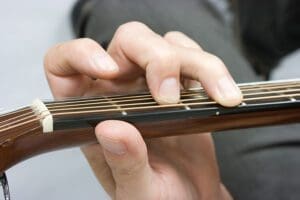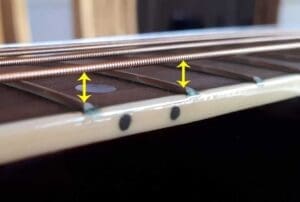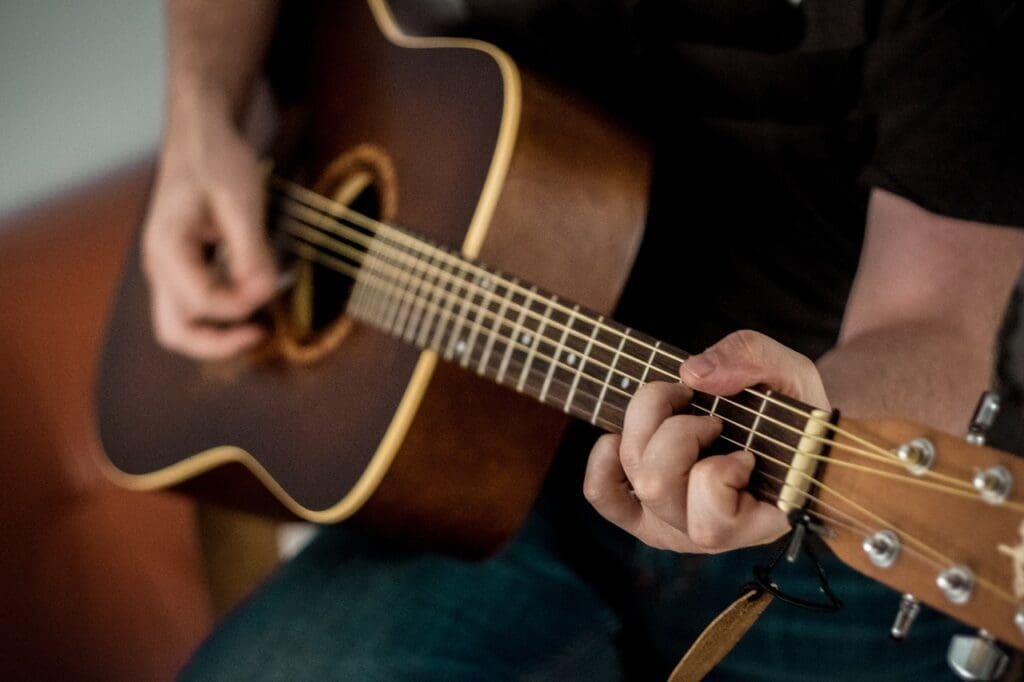Last update 5/2/2024
Guitar finger pain and how to fix it. Finger pain is most common amongst beginners; their fingers need time to become “conditioned” to push guitar strings down behind the frets.
Table of contents
Important preface
We want to preface this article by saying if you are experiencing really painful hands or fingers, get medical advice.
Guitar finger pain is a bummer, especially when you’re just starting out. But don’t worry; you can do a few things to ease the pain and keep playing.
If you are an experienced guitar player and are experiencing sore fingers, it most often means that you’re using excess pressure when fretting chords or even single notes. This article speaks to beginners and experienced players, as the solutions are almost identical.
If you are learning to play the guitar, the discomfort will generally continue for the first few weeks, depending on how much you play. The good news is that the proper technique will stop your fingers from hurting if applied correctly. Our article assumes that you are playing a steel-string guitar.
Nylon-stringed
Guitars, such as classical guitars, have less string tension and are less prone to causing the same issues discussed in this article.
Guitar finger pain| Beginning guitarist’s
Playing a note or a chord requires pressing a steel or multiple strings under tension onto a metal fret as you play your guitar. To fret a guitar string correctly, the player must apply pressure to the strings with the fingertips directly behind the fret.
Overcoming the tension of the strings is the main reason a guitarist’s fingers may become sore. As a new player, It is vital to only play for short periods when you first begin playing. Be sure to stop and take regular breaks. Do so well before the pain increases to a high level of discomfort.
Finger pain | Experienced guitarists
Most of the medical ailments that guitarists experience are usually due to improper posture. Unfortunately, too many guitarists don’t consider correct posture or give it enough respect. Get into the habit of practicing proper posture until it becomes ingrained and automatic.
Remember that incorrect posture may not show any symptoms until the damage is done. Review your technique if you’re a player who plays lots of string bends. Suppose you have it wrong, then that’s another common reason for sore fingers.
What is finger pain?


Finger pain associated with guitar playing is usually soreness in the finger joints or,
most often, at the fingertips. The cause is too much pressure applied when the fingers contact the guitar strings. Of course, pressure does need to be used, but the problem is that the player often applies excessive force, which results in pain.
The pain is felt due to damage done to the tissues in the fingertips; to a degree, this is a normal process for new players. The injury will heal itself, and calluses will form in time.
Calluses
Beginners commonly complain of soreness in their fingertips because the fingers are still soft at the tips. The condition will improve as the skin hardens naturally (calluses will develop).
The solution
Usually, there is no need for long-winded solutions for this issue. It’s easy to fix. Begin the exercise by placing your first finger behind the 5th fret on the 3rd string as an exercise. Apply a little pressure to the first finger behind the 5th fret on the 3rd string. Pluk the string gently on the 3rd string with your thumb.
“There’s a weird period of learning how to play guitar where your fingers are constantly messed up a handful.” – Jason Reeves


Now, relax the pressure a little at a time. Take note of how little pressure you need before the note begins to buzz.
In other words, relax the tension in your finger that is fretting the note until the note stops sounding clean or the string starts to buzz. It may surprise you how little pressure is required to fret the note cleanly, utterly buzz-free.
The time you spend practicing this will pay dividends throughout your guitar-playing life. If you ever notice any signs of sore fingers after playing the guitar, Review the procedure we have discussed here today.
Prevention
Bad habits, such as bad posture, can become habitual very quickly. Bad habits can occur regardless of playing experience. We recommend spending a few minutes reviewing your finger pressure and posture in each practice session. Pain is your body telling you something isn’t quite right.
- If you are playing for long periods, try to rest your fingers when possible.
- If you experience pain in your fingers and or hands, stop playing.
- Playing four times in an hour with breaks is better than 1 hour without a break.
- Give your hands and fingers time to recover. Minimize or stop playing when your hands and fingers are sore.
If you find the soreness persists, try lighter gauge guitar strings. Lighter strings are easier to fret and bend.
Guitar action


Have a professional check your guitar’s action. When described, a guitar’s action means the strings’ height above the frets. When set to high, the action will make fretting much more complex compared to when the action is set low.
- Keep your fretting hand fingernails short.
- Do warmup exercises before playing.
- Pain is a warning; do not continue playing if the pain is anything more than minor.
Guitar players who experience sore fingertips or discomfort in the joints of their fingers should follow our advice as already outlined. In most cases, the pain will stop. Experienced or professional guitar players use a very light touch. Playing with a soft touch takes practice. Perfecting a light touch should be a part of every guitar player’s practice routine. It should be part of yours also.
Bad habits can creep in quickly and be difficult to correct if left unchecked.
- However, if you continue to experience pain in your fingers after reviewing the finger pressure in the described manner, seek medical advice or a physical therapist.
- If you are in pain and uncertain about anything, seek medical advice.
Anyway, here are some tips
Take breaks often. Don’t try to play for hours on end without taking a break. Rest your fingers for a few minutes every 15-20 minutes.
Use light gauge strings. Lighter gauge strings are easier to press down on, which will reduce the strain on your fingers.
Check your guitar’s action. The action is the height of the strings above the fretboard. If the action is too high, pressing down on the strings will be harder, which can cause sore fingers. If you’re unsure, get a qualified guitar technician to check it out.
Learn to use good technique. Ensure you are using the correct fingering and not pressing down on the strings harder than necessary. ( pressing too hard is one the most common reasons for guitar players to experience sore fingers)
Soak your fingers in warm water before and after playing. This will help to soften your skin and reduce calluses.
Severe finger pain
No matter what type of guitar you’re playing, you should see a doctor or physical therapist if you’re experiencing severe finger pain or if the pain does not improve after taking the above steps.
Which fingers are getting sore?
Sometimes, it’s only some fingers that get sore. Let’s break it down by each finger.
Index finger pain
The index finger is often the first finger to develop calluses, as it is used to press down on most strings. Try using light gauge strings, which should make it easier to fret notes.
Ring finger pain
The ring finger is often the weakest finger, so it can be more susceptible to becoming sore. As mentioned above, try light gauge strings to check the action of the guitar.
Pinky finger pain
The pinky finger is often the least used, making it more susceptible to soreness or pain. Light gauge strings and proper action will help. Allow some time to build up strength in your pinky. Time and perseverance are needed here.
Conclusion
We hope you heed the advice given in this article and enjoy your guitar playing in the best of health well into the future. Be sure to remember that guitar finger pain can be a challenging hurdle for beginners and seasoned players alike.
Be sure to use proper techniques:
Be sure to allow for adequate rest, and gradually building strength and endurance are pivotal in overcoming this discomfort.
Remember, by listening to your body, employing effective strategies, and seeking guidance when needed, you can alleviate finger pain and progress toward playing the guitar with both skill and comfort. Keep strumming and practicing; soon enough, you should be able to play the guitar without discomfort.
Resources
Jewell, T. (2019, November 19). Guitar fingers: Build calluses, relieve pain, and avoid injury. Healthline. Retrieved December 3, 2021, from https://www.healthline.com/health/guitar-fingers#causes-of-finger-pain.



